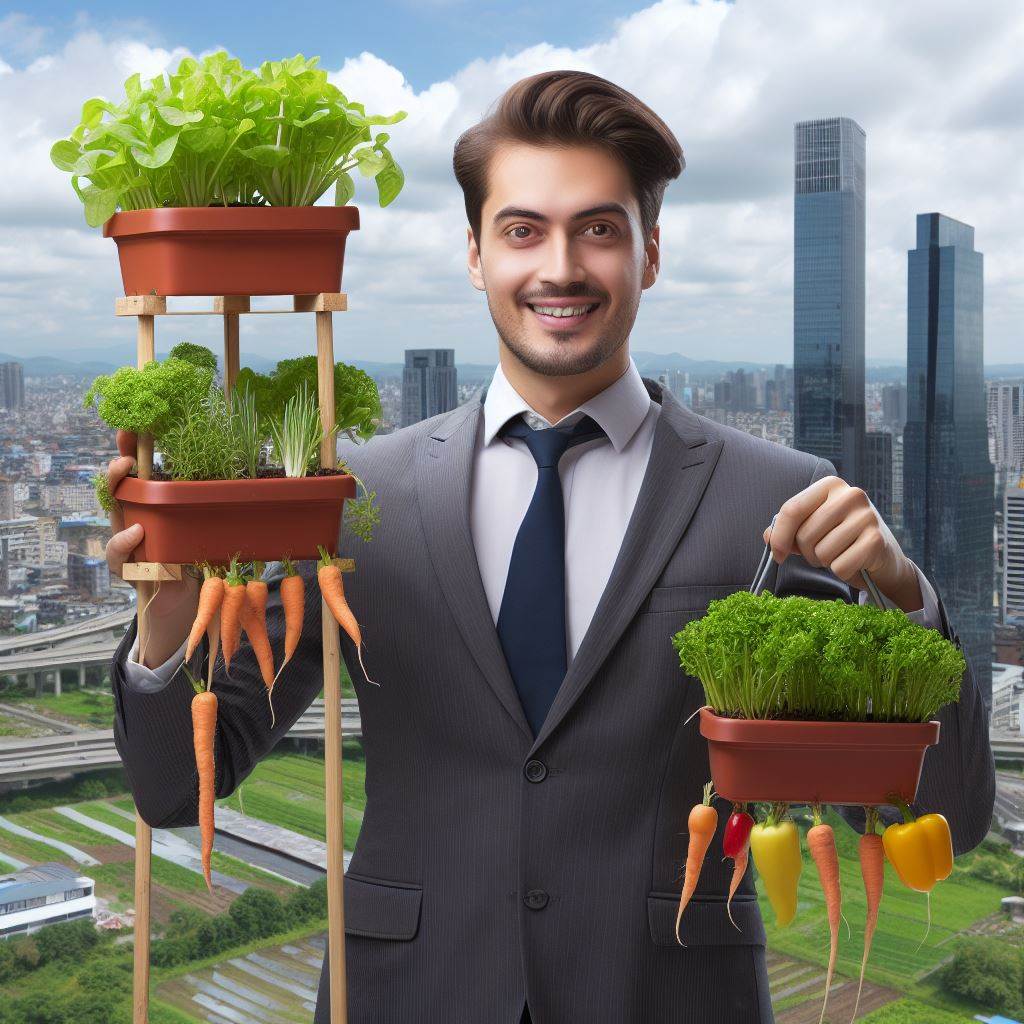Rooftop Farming: Sky-High Veggie Tips
Last Updated on February 28, 2024
Introduction to rooftop farming
Let’s Explore Rooftop Farming: Sky-High Veggie Tips
Rooftop farming, also known as rooftop gardening, is a practice of growing plants and crops on the rooftops of buildings.
It involves using various techniques and systems to utilize the unused space on rooftops for agricultural purposes.
Increasing popularity and benefits of rooftop farming
The concept of rooftop farming has been gaining popularity in recent years due to the increasing urbanization and the limited availability of land for traditional farming.
It is considered a sustainable and efficient way of producing food in urban areas.
Rooftop farming offers numerous benefits.
Firstly, it enables individuals to have access to fresh and organic produce, reducing their reliance on imported and conventionally grown food.
It also helps in reducing food miles and carbon emissions associated with the transportation of food.
Furthermore, rooftop farming can contribute to urban heat island mitigation by reducing the heat absorbed by buildings and improving air quality.
It also acts as a natural insulator, reducing energy consumption for cooling and heating purposes.
In addition to these environmental benefits, rooftop farming can have social and economic advantages as well.
It can create job opportunities, promote community engagement, and enhance the overall aesthetics of urban landscapes.
Therefore, rooftop farming is an innovative and sustainable solution to the challenges of food production and urban living.
It presents a unique opportunity for individuals, communities, and cities to embrace urban agriculture and foster a more resilient and self-sufficient future.
Location selection
Rooftop farming is gaining popularity as an efficient way to grow fresh produce in urban areas.
However, before starting a rooftop farm, there are several factors to consider.
In this section, we will discuss the important aspects of location selection for a successful rooftop farming venture.
Assessing structural feasibility and load-bearing capacity
First and foremost, choosing the right location is crucial for rooftop farming.
Assessing the structural feasibility and load-bearing capacity of the rooftop is essential to ensure the safety of both the plants and the building.
It is necessary to consult a structural engineer to determine if the rooftop can handle the added weight of the farm.
Access to sunlight and water sources
Access to sunlight and water sources is another key factor to consider.
Plants need an adequate amount of sunlight to thrive, so selecting a location that receives ample sunlight throughout the day is essential.
Additionally, access to a reliable water source, whether through a nearby faucet or a rainwater harvesting system, is necessary for irrigation.
Availability of space and wind exposure
Availability of space is another consideration.
Rooftops come in different shapes and sizes, so it is important to evaluate the available space and plan accordingly.
Some crops may require more space to grow, while others can be grown in containers or vertical structures to optimize space utilization.
Wind exposure is also a significant factor to take into account.
Rooftops are often more exposed to wind compared to ground-level gardens.
Strong winds can damage crops and disrupt their growth.
It is important to assess wind exposure and take appropriate measures to protect the plants, such as installing windbreaks or creating sheltered areas.
To summarize, when selecting a location for rooftop farming, several factors need to be considered.
These include assessing the structural feasibility and load-bearing capacity, ensuring access to sunlight and water sources, evaluating space availability, and accounting for wind exposure.
Considering these factors will help ensure the success of a rooftop farming venture.
Most importantly, rooftop farming is an innovative approach to sustainable agriculture in urban areas.
By making informed decisions regarding location selection, rooftop farmers can create thriving vegetable gardens on top of buildings.
The benefits of rooftop farming extend beyond just providing fresh produce – it also promotes green spaces, reduces food transportation costs, and contributes to a greener and healthier environment.
So, if you’re thinking of starting a rooftop farm, be sure to carefully consider the location to maximize your chances of success.
Happy rooftop farming!
Read: Indoor Gardening: Veggies & Fruits Year-Round
Choosing suitable vegetables for rooftop farming
Factors to consider: climate, sunlight, etc
Rooftop farming has become a popular trend in urban areas as people look for innovative ways to grow their own food.
However, choosing suitable vegetables for rooftop farming requires careful consideration of various factors such as climate, sunlight, and space availability.
Here are some tips for selecting the right vegetables for your rooftop farm:
- Climate: The first thing to consider is the climate in your area. Some vegetables thrive in warm climates, while others prefer cooler temperatures. Research the recommended varieties for your specific climate zone.
- Sunlight: Adequate sunlight is crucial for vegetable growth. Ensure that your rooftop receives at least 6-8 hours of direct sunlight each day. Leafy greens like lettuce and spinach can tolerate partial shade, but fruiting plants like tomatoes and peppers require full sun.
- Space availability: Rooftop gardens often have limited space, so it’s essential to choose vegetables that are suitable for small areas. Look for compact or dwarf varieties that can be grown in containers or vertical gardens.
- High adaptability: Opt for vegetables that have a high adaptability to different growing conditions. Some resilient options include Swiss chard, kale, radishes, and herbs like mint and basil.
- Water requirements: Consider the water availability and the ease of irrigation on your rooftop. Vegetables like lettuce, spinach, and Swiss chard have relatively low water needs, making them ideal for rooftop farming.
- Soil quality: Check the quality of your rooftop soil. If it’s poor, you may need to improve it before planting. Consider using raised beds or containers filled with good quality potting mix.
- Pest and disease resistance: Select vegetables that are resistant to common pests and diseases. This will help minimize the use of chemical pesticides and ensure healthier yields. Examples include beans, peas, and garlic.
Best practices for selecting seeds or seedlings
When selecting seeds or seedlings for your rooftop farm, follow these best practices:
- Choose reliable sources: Buy seeds or seedlings from reputable sources to ensure their quality and authenticity. Look for certified organic options if you prefer to grow without synthetic chemicals.
- Consider heirloom varieties: Heirloom seeds offer genetic diversity and have been treasured for their taste and unique traits. They are often more adaptable to different growing conditions.
- Read labels and descriptions: Pay attention to the information provided on seed packets or plant labels. It will help you understand the plant’s requirements and whether they are suitable for your rooftop farm.
- Start with healthy seedlings: If you’re starting with seedlings, choose ones that are healthy and disease-free. Avoid leggy or stunted plants as they may struggle to establish in the rooftop environment.
- Try companion planting: Pairing compatible plants together can improve their overall health and deter pests. For example, planting marigolds alongside tomatoes can help repel nematodes.
Most importantly, rooftop farming can provide a sustainable way to grow vegetables in urban areas.
When selecting suitable vegetables, consider the climate, sunlight availability, and space limitations.
Opt for adaptable varieties, pay attention to water and soil requirements, and choose pest-resistant options.
When selecting seeds or seedlings, rely on reputable sources, consider heirloom varieties, and start with healthy plants.
By following these guidelines, you’ll be on your way to a successful rooftop garden filled with nutritious and delicious veggies.
Read: Patio Herb Gardens: Simple Steps to Start
Preparing the rooftop for farming
Rooftop farming is a growing trend in urban areas, allowing people to cultivate their own vegetables and herbs in limited spaces.
However, before diving into this exciting endeavor, proper preparations must be made to ensure a successful rooftop farm.
Here are some essential steps to get started:
Clearing the area and removing debris
The first step is to clear the rooftop of any debris or unwanted items.
This will provide a clean canvas for your rooftop farm and minimize the risk of pests and diseases.
Securing raised beds or containers
Once the area is clear, it’s time to decide on the type of farming system you want to adopt.
Raised beds and containers are popular choices as they provide a controlled environment for plant growth.
Secure these structures properly to prevent any accidents or damage to the rooftop.
Soil selection and preparation techniques
Good quality soil is the key to successful farming.
Choose a lightweight soil mix that is specifically formulated for rooftop gardening.
It should be well-draining to prevent waterlogging.
Additionally, consider adding organic matter to improve fertility and moisture retention.
Installing a proper irrigation system
Since rooftops are exposed to direct sunlight and wind, irrigation is crucial to maintain optimal moisture levels for plant growth.
Installing a drip irrigation system or using self-watering containers can provide efficient watering without wasting water.
Selecting suitable vegetable varieties
Not all vegetables thrive in the rooftop environment.
Choose plants that are well-suited for rooftop farming, such as leafy greens, herbs, and compact root vegetables.
Consider the available space, sunlight exposure, and your personal preferences when making your selection.
Providing adequate sunlight
Most vegetables require at least six hours of direct sunlight daily.
Ensure that your rooftop receives sufficient sunlight by minimizing obstructions like tall buildings or trees that can cast shadows.
If necessary, use reflective materials to redirect sunlight towards the plants.
Implementing pest control measures
Rooftop farms are not immune to pests and diseases.
Regularly monitor your plants for signs of infestations and take immediate action if necessary.
Use organic pest control methods like neem oil, beneficial insects, or physical barriers to protect your crops.
Regular maintenance and crop rotation
Like any other garden, rooftop farms require regular maintenance.
This includes watering, fertilizing, and pruning as needed.
Additionally, practice crop rotation to prevent nutrient depletion and reduce the risk of pests and diseases.
Harvesting and enjoying the rewards
One of the most enjoyable aspects of rooftop farming is harvesting your own fresh produce.
Harvest the vegetables at their peak of ripeness to enjoy maximum flavor and nutrition.
Use your organic rooftop bounty in delicious recipes or share them with friends and neighbors.
Continuous learning and improvement
Rooftop farming is a continuous learning process.
Stay updated with the latest techniques, attend workshops or webinars, and connect with other rooftop farmers to exchange knowledge and experiences.
Embrace experimentation and always strive for improvement in your rooftop farm.
With proper preparations, a well-maintained rooftop farm can thrive and provide a bountiful harvest of delicious and nutritious vegetables.
Start your own rooftop farm today, and experience the joy of growing your own food while contributing to a sustainable urban environment.
Read: Future Farming: The Rise of Aquaponics

Irrigation and watering systems
Irrigation and watering systems are essential for rooftop gardens to thrive and produce healthy vegetables.
With limited space and water availability, choosing the right watering system is crucial.
Here are some different options and techniques for efficient water management in rooftop farming:
Drip Irrigation Systems
Drip irrigation is a popular choice for rooftop gardens as it ensures precise watering and minimizes water wastage.
It involves installing a network of tubes that deliver water directly to the plant’s roots.
Micro-sprinklers
Micro-sprinklers are another effective option for rooftop gardens.
These small sprinkler heads provide a gentle spray of water, covering a larger area compared to drip irrigation.
They are suitable for plants that don’t require deep watering.
Hand Watering
In smaller rooftop gardens, hand watering can be a practical choice.
By using a watering can or hose with a nozzle, gardeners can control the amount of water each plant receives.
This method allows for careful attention to individual plants’ needs.
Capillary Mats
Capillary mats are useful for water-efficient rooftop gardening.
They consist of absorbent fabric placed under the plants, allowing moisture to move upward through capillary action.
The roots draw water as needed, reducing excess watering and water loss through evaporation.
Green Roof Systems
Incorporating a green roof system can contribute to efficient water management.
Green roofs are composed of layers that absorb rainwater, reducing runoff and providing a natural irrigation source for plants.
This system helps retain water and reduces the need for external irrigation.
Rainwater Harvesting
Collecting rainwater is an eco-friendly approach to watering rooftop gardens.
Installing rain barrels or cisterns can capture rainwater from rooftops, which can then be used for irrigation during dry periods.
This method conserves water and reduces reliance on municipal water supplies.
Self-Watering Containers
Self-watering containers are an innovative solution for rooftop gardening.
These containers have built-in reservoirs that store water, supplying it to the plants as needed.
They reduce the frequency of watering and provide a consistent water supply for healthier plant growth.
Mulching
Applying mulch to the soil surface helps retain moisture and regulate soil temperature in rooftop gardens.
Mulch reduces evaporation, suppresses weed growth, and improves water infiltration, resulting in less frequent watering requirements.
Efficient Watering Practices
Adopting efficient watering practices is vital for rooftop farming success.
Watering during early morning or late evening reduces evaporation and ensures maximum water absorption by the plants.
Regular monitoring of soil moisture levels can help adjust watering frequency accordingly.
Smart Irrigation Controllers
Using smart irrigation controllers can optimize water usage in rooftop gardens.
These controllers monitor weather conditions, soil moisture levels, and plant water requirements.
By adjusting watering schedules automatically, they prevent overwatering and save water resources.
In essence, choosing the appropriate irrigation and watering system is essential for rooftop farming.
Whether it’s drip irrigation, micro-sprinklers, or self-watering containers, efficient water management techniques can ensure healthy and productive rooftop gardens.
Implementing these methods, along with proper watering practices, can promote sustainable urban agriculture and improve food production in limited spaces.
Read: Container Gardening: Veggies on Your Patio
Maintenance and care
Roof maintenance and care are essential for successful rooftop farming.
Here are some tips to ensure your rooftop garden thrives:
Regular monitoring of plants’ health
Check for any signs of diseases or nutrient deficiencies in your plants.
Inspect the foliage, stems, and roots for any abnormalities.
Pest control measures
Implement integrated pest management techniques to keep pests at bay.
This includes using natural predators, organic sprays, or physical barriers.
Fertilization and composting methods
Provide your plants with proper nutrients by using organic fertilizers and compost.
Regularly replenish the soil with compost to enrich its fertility.
Watering schedule
Develop a watering routine based on your plants’ needs.
Monitor the moisture levels in the soil and adjust watering accordingly; avoid overwatering or underwatering.
Weeding
Regularly remove weeds to prevent competition for nutrients and water.
Pull out weeds by hand or use natural weed control methods.
Pruning and trimming
Trim your plants regularly to remove dead or damaged parts.
Pruning encourages healthier growth and improves air circulation.
Sun exposure
Ensure your rooftop garden receives adequate sunlight.
Place plants in areas that get maximum exposure to sunlight throughout the day.
Wind protection
Protect your plants from strong winds by installing windbreaks or using trellises, screens, or fences.
This will prevent wind damage to delicate plants.
Mulching
Apply a layer of organic mulch around your plants to conserve moisture, suppress weed growth, and regulate soil temperature.
Soil testing
Conduct periodic soil testing to assess its pH levels and nutrient content.
Adjust the pH and add necessary nutrients based on the test results.
Disease prevention
Avoid the spread of diseases by practicing good hygiene.
Disinfect tools and equipment before and after use to minimize the risk of infections.
Harvesting and pruning methods
Harvest crops when they reach their optimal stage to promote continuous growth.
Use proper pruning techniques to stimulate new growth and maintain plant shape.
Seasonal adjustments
Adjust your maintenance practices according to the changing seasons.
Winterize your rooftop garden by insulating plants and protecting them from frost.
Record keeping
Maintain a detailed record of the plants’ growth, pest issues, and maintenance activities.
This will help you track progress and make informed decisions in the future.
Remember, rooftop farming requires dedication and regular attention.
By following these maintenance and care tips, you can create a thriving rooftop garden that yields a bountiful harvest.
Harvesting and utilizing rooftop produce
- Timing is crucial when harvesting rooftop-grown vegetables to ensure peak flavor and nutritional value.
- Look for visual cues such as vibrant colors, firm textures, and ripe appearance to determine readiness for harvest.
- Use sharp shears or a knife to cut vegetables at the base, avoiding any damage to the plants.
- Harvest leafy greens and herbs by removing outer leaves or trimming from the top, allowing for continued growth.
- Remember to handle delicate produce with care to prevent bruising or crushing during the harvesting process.
Tips for Harvesting Vegetables at Their Peak
- Regularly monitor your rooftop garden for signs of maturity, as certain vegetables may have specific harvest times.
- It’s best to pick vegetables early in the morning or late in the evening when they are cool and turgid.
- Avoid over-ripening by harvesting larger vegetables before they become oversize and lose their ideal taste and texture.
- For vine crops like cucumbers and squash, gently twist and lift to detach them from the stem when fully ripe.
- Wipe off any excess dirt or debris from freshly harvested vegetables to maintain cleanliness.
Proper Storage and Preservation Techniques
- Immediately after harvest, gently wash vegetables to remove dirt, being cautious not to damage any delicate leaves.
- Dry vegetables thoroughly before storage to prevent rotting, using a clean towel or spinning them in a salad spinner.
- Store vegetables in sealed containers or resealable bags, removing excess air to maintain freshness and prevent spoilage.
- Maintain proper temperature and humidity levels in storage areas to extend the shelf life of harvested vegetables.
- Some vegetables, like carrots and beets, can be stored in a cool, dark place for an extended period of time, whereas others require refrigeration.
Ideas for Using Rooftop-Grown Vegetables in Recipes
- Freshly harvested rooftop-grown vegetables are ideal for creating vibrant salads packed with flavor and nutrients.
- Try incorporating rooftop produce into stir-fries, soups, stews, and pasta dishes to add an extra dimension of freshness.
- Roasting or grilling vegetables like peppers, eggplants, and zucchini enhances their natural flavors.
- Blend rooftop-grown herbs into pestos, sauces, or dressings for a burst of aromatic goodness.
- Get creative and experiment with pickling rooftop-grown vegetables to enjoy their crispness and tanginess year-round.
In fact, rooftop farming offers an innovative solution to address urban food production challenges.
By mastering the art of harvesting, utilizing proper storage techniques, and exploring exciting recipes, one can fully enjoy the rewards of rooftop-grown vegetables.
So go ahead, cultivate your own urban oasis and savor the sky-high flavors of rooftop farming!
Community benefits and social impact
In recent years, rooftop farming has gained popularity as a sustainable solution for urban environments.
This innovative practice offers numerous community benefits and has a significant social impact.
- Rooftop farming promotes healthy eating habits by providing fresh and organic vegetables to the community.
- By reducing the distance between food production and consumption, it helps minimize carbon emissions associated with transportation.
- Not only does it contribute to improved air quality, but it also lowers the urban heat island effect by creating green spaces.
- Rooftop farms can serve as gathering places for the community, fostering a sense of connection and enhancing social interactions.
- By involving the community in the farming process, it promotes a shared responsibility for sustainable food production.
Creating Green Spaces in Urban Environments
- Urban environments often lack green spaces, but rooftop farming can transform vacant rooftops into vibrant gardens.
- These green spaces help improve the aesthetics of the cityscape, creating a visually pleasing atmosphere.
- Rooftop farms also contribute to biodiversity preservation by providing habitats for pollinators and other beneficial insects.
- They act as insulation for buildings, reducing energy consumption and increasing overall energy efficiency.
- Additionally, these green rooftops mitigate stormwater runoff, reducing the strain on urban infrastructure.
Promoting Sustainability and Food Security
- With increasing global populations, ensuring food security is crucial. Rooftop farming can play a significant role in achieving this goal.
- By utilizing underutilized spaces, it optimizes land use and conserves valuable resources like water and soil.
- The use of vertical farming techniques on rooftops maximizes crop yields, allowing for higher food production in limited space.
- Local production reduces reliance on long-distance transportation, making the food system more resilient and sustainable.
- Rooftop farming also reduces the need for pesticides and synthetic fertilizers, promoting organic and environmentally friendly practices.
Potential for Community Engagement and Education
- Rooftop farms provide excellent opportunities for community engagement, as individuals can actively participate in the farming process.
- Through educational programs, workshops, and guided tours, people can learn about sustainable practices and the importance of locally grown food.
- Children and adults alike can benefit from hands-on learning experiences, fostering a connection with nature and food production.
- These educational initiatives also raise awareness about the environmental impact of conventional farming and the benefits of rooftop farming.
- By involving the community in the decision-making process, rooftop farms foster a sense of ownership and empowerment.
In short, rooftop farming presents numerous benefits for communities and has a positive social impact.
By creating green spaces, promoting sustainability, and providing opportunities for community engagement and education, it contributes to a more vibrant and resilient urban environment.
Embracing rooftop farming is a step towards a greener and healthier future.
Conclusion
Rooftop farming offers numerous benefits such as increased access to fresh and organic produce.
It also helps to reduce the carbon footprint and promote sustainability in urban areas.
Throughout this blog secction, we have discussed various tips to get started with rooftop farming, including choosing the right crops, utilizing space efficiently, and implementing proper irrigation systems.
These tips will ensure a successful and productive rooftop farm.
We have also emphasized the importance of community involvement and the potential for rooftop farms to become social hubs, bringing people together around a shared passion for healthy and sustainable living.
I encourage everyone to explore the possibilities of rooftop farming.
It is a unique and rewarding experience that allows you to reconnect with nature in an urban setting.
By taking action and trying it out yourself, you can contribute to a greener and more resilient city.
So, go ahead and start your own rooftop farm.
Whether you have a small balcony or a spacious rooftop, there is always room to grow and make a difference.
Don’t be afraid to experiment and learn from others in the rooftop farming community.
Who knows, you might discover a new hobby or even a new career path!
Remember, the sky is not the limit when it comes to rooftop farming.
With a bit of creativity, determination, and a green thumb, you can transform your rooftop into a thriving and sustainable oasis.
Happy farming!


